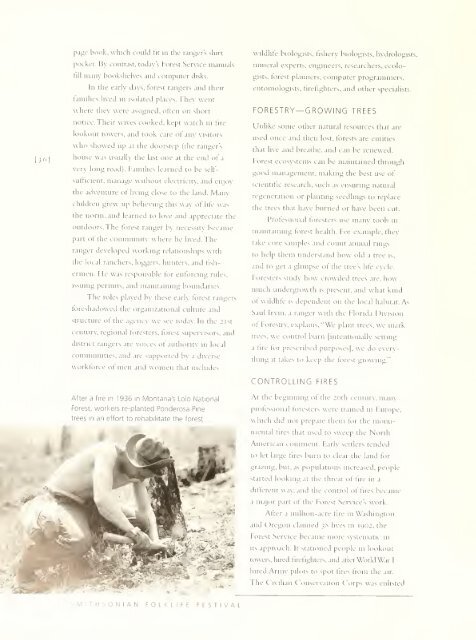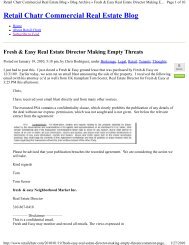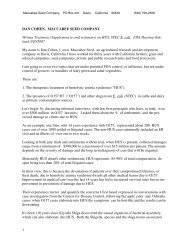I[3 6]page book, which could fit in the rangers shirtpocket. By contrast, todays Forest Service manualstillmany bookshelves and computer disks.In the early days, forest rangers and thenfamilies lived in isolated places. They wentwhere they were assigned, often on shortnotice. Their wives cooked, kept watch infirelookout towers, and took care of any visitorswho showed up at the doorstep (the ranger'shouse was usually the last one at the end of avery long road). Families learned to be selfsufficient,manage without electricity, and enjo)the adventure of living close to the land. Manychildren grew up believing this way of life wasthe norm, and learned to love and appreciate theoutdoors. The forest ranger by necessity becamepart of the community where he lived. Theranger developed working relationships withthe local ranchers, loggers, hunters, and fishermen.He was responsible for enforcing rules,issuing permits, and maintaining boundaries.The roles played by these early forest rangersforeshadowed the organizational culture andstructure of the agency we see today. In the 2 1stcentury, regional foresters, forest supervisors, anddistrict rangers are vences of authority in localcommunities, and are supported by a diverseworkforce ot men and women that includeswildlife biologists, fishery biologists, hydrologists,mineral experts, engineers, researchers, ecologies,forest planners, computer programmers,entomologists, firefighters, and other specialistsFORESTRY—GROWING TREESUnlike some other natural resources that areused once and then lost, forests are entitiesthat live and breathe, and can be renewed.Forest ecosystems can be maintained throughgood management, making the best use ofscientific research, such as ensuring naturalregeneration or planting seedlings to replacethe trees that have burned or have been cut.Professionalforesters use mam tools inmaintaining forest health. For example, theytake core samples and count annual ringsto help them understand how old a tree is,and to get a glimpse of the tree's life cycle.Foresters study how crowded trees are. howmuch undergrowth is present, and what kindof wildlife is dependent on the local habitat. AsSaul Irvin.a ranger with the florida DivisionotForestry, explains, "We plant trees, we marktrees, we control burn [intentionally settinga fire for prescribed purposes], we do everythingit takes to keep the forest growing."After a fire in 1936 in Montana's Lolo NationalForest, workers re-planted Ponderosa Pinetrees in an effort to rehabilitate the forest.CONTROLLING FIRESAt the beginning of the 20th century, manyprofessional foresters were trained 111 Europe,winch did not prepare them for the monumentaltiresthat used to sweep the NorthAmerican continent. Early settlers tendedto let large fires burn to clear the land forgrazing, but. as populations increased, peoplestarted looking at the threat of fire in adifferent way, and the control of tires becameamajor part of the Forest Service's work.After a million-acre tire in Washingtonand Oregon claimed 38 lives 111 1902. theForest Service became more systematic mits approach. It stationed people in lookouttowers, hired firefighters, and after World War Ihired Army pilots to spot firesfrom the air.he Civilian Conservation Corps was enlistedSMITHSONIAN FOLKLIFE FESTIVAL
. . [The[3 7]Fully suited, these smokejumpers in 1952 practice parachute-steeringmaneuvers while also strengthening their arm and shoulder muscles.during the 1930s to tight fires throughoutthe West. In1940, Rufus Robinson and EarlCooley became the world's first smokejumpers,parachuting into Idaho's Nez Perce NationalForest. Today, airplanes and helicopters drop notonly firefighters and equipment on tire linesbut also water and tire-retardant chemicals.Forest Service researchers are very proactivein studying fire and how it affects forestsm the long run. They consider whether it isbetter to stop firesfireor let them burn and howmight actually improve wildlife habitatand encourage the growth ot new trees. Fireresearchers manage torests to make them moreresilient to wildfire by removing underbrushand excess trees that literally add fuel to the tire.Sometimes they even use tire as a prescriptionto restore health to a forest that is overgrownor has the potential to burn out ot control.The history ot fire prevention intheForest Service is as old as the agency. Formany employees, their first job was keepinga 360 o vigil from a tire lookout tower, oftenspending their days m solitude. While lookoutsdo have contact with the outside world, theyhave had to find ways to fill their time. Theymight be found playing the guitar, writinga novel, or even riding an exercise bike.Donna Ashworth of Arizona has spent 26consecutive seasons on lookout tower duty.Ashworth doesn't feel alone when she ism the lookout tower, however, because she issittingconnected to others via radio. She describes herjob poetically:"! never get tired of it. It's alwaysbeauty. It's always the drama in the skyI live m the air. I can see 60, So. 100 miles."Ot course, lookouts are only onepart of the fire workforce. Others, suchas smokejumpers and firefighters, experiencefire from a very different perspective.As Kelly Esterbrook, a former smokejumperfrom Oregon, observes, "You definitelyhave to like to be physical. You just don'tget through the training program if youdon't enjov it. You have to like adventure.It's probably the best job I've ever had."Firefighters enjoy the challenge and thecamaraderie of the work. Linda Wadleigh. .1fire ecologist from Flagstaff, Arizona, beganas a forester but ended up as a firefighter.Wadleigh recalls, "Here I was a forestry major,and I decided I had a real love for fire. I wasraised a forester, but I was baptized in tire."She describes firefighting as compelling."Being called on a fire is one ot the strangestexperiences. .love ot tiretightmg] isa genetic disorder. . . . Once you smell thesmoke, it brines out the flaw in your DNA."FOREST SERVICE, CULTURE, AND COMMUNITY
- Page 1: Smithsonianolklife Festival\Food Cu
- Page 4 and 5: The annual Smithsonian Folklite Fes
- Page 7 and 8: —CONTENTSThe Festival's Timely Ap
- Page 9 and 10: —THE FESTIVAL'S TIMELY APPEALLAWR
- Page 11 and 12: COMMERCE FOR CULTUREFrom the Festiv
- Page 13 and 14: [ii]The food concession for the Mel
- Page 15 and 16: oMiiitbioni.indotal SoundL04.A 1 Sl
- Page 17: 1WELCOME TO THE 2005 FOLKLIFE FESTI
- Page 20 and 21: Workers harvest artichokes at Ocean
- Page 22 and 23: —assigned aparticular dish—meat
- Page 24 and 25: I--IPot Pie Farm manager Elizabeth
- Page 26 and 27: ISustainable farmers such as Eliot
- Page 28 and 29: "IThe numberof programsdesignedfor
- Page 30 and 31: .hadSALAD GREENS WITH GOAT CHEESE,
- Page 32 and 33: w.A>wm:~
- Page 34 and 35: —3 3]OCCUPATIONAL CULTUREThe 2005
- Page 36 and 37: employees, the USDA Forest Servicei
- Page 40 and 41: ká.!i- .>!mKPA backpacker sets up
- Page 42 and 43: --^i'liunterw eight jihI ...itl jib
- Page 44 and 45: —4-"The essentialpiece isto captu
- Page 46 and 47: I44cutDUTCH OVENONE-POT MEALThomas
- Page 48 and 49: —FUTURE CONCERNS FOR PUBLIC LANDS
- Page 50 and 51: NUESTRA MÚSICA: MUSIC INBuilding C
- Page 52 and 53: plena groups throughout the Northea
- Page 54 and 55: NUESTRA MÚSICA LAUNCHES NEW SERIES
- Page 56 and 57: NUESTRA MÚSICA: MUSIC IN LATINO CU
- Page 58 and 59: "ILos Camperos de Valles son músic
- Page 60 and 61: RAICES LATINASNUESTRA MÚSICA LANZA
- Page 63 and 64: IOMAN: DESERT, OASIS, AND SEARICHAR
- Page 65 and 66: DESERTThe deserts ot the Arabian Pe
- Page 67 and 68: THE FESTIVAL PROGRAMThe 200s Smiths
- Page 70 and 71: 6 8The coiled, leather-covered bask
- Page 72 and 73: 70]COASTAL CRAFTSMANSHIPAND GLOBAL
- Page 74 and 75: [72]Although the oldismaking way fo
- Page 76 and 77: AN OMANI FOLKTALEASYAH AL-BUALYOman
- Page 79 and 80: y%aMUSIC AND DANCE INOMANOMAN CENTR
- Page 81: In the southern Dhufar region, al-b
- Page 84 and 85: ecosystems, identification of plant
- Page 86 and 87: 2:00IIIVorkshopFESTIVAL SCHEDULE (P
- Page 88 and 89:
Rhythm,Saturday, June 25 (Programs
- Page 90 and 91:
)avidi nestMonday, June 27(Programs
- Page 92 and 93:
1:00IIlamFriday, July 1 (Programs a
- Page 94 and 95:
)utchSunday, July 3(Programs are su
- Page 96 and 97:
EVENING CONCERTSSounds of the Fores
- Page 98 and 99:
theRELATED EVENTS[96]Nuestra Músic
- Page 100 and 101:
IIDónalas Anderson,Washington, D.C
- Page 102 and 103:
'IEd LiíDmi, Studio City, Californ
- Page 104 and 105:
ISudhir Seth, Bethesda, MarylandA g
- Page 106 and 107:
1 if 1 DumberHoneyBeehive Beeproduc
- Page 108 and 109:
1"''NewI >onI Lui\IDon Bustos,Espa
- Page 110 and 111:
Ian Barlow, White Bird,Idaho; Woodl
- Page 112 and 113:
I 'istnet1Gordon Grant,Corvallis, O
- Page 114 and 115:
Kristen Marline, Flagstaff,Arizona;
- Page 116 and 117:
I1 ountries,IIHistorie Site, once t
- Page 118 and 119:
1IworksI1 11Istations are vital to
- Page 120 and 121:
1'IenIpanderetas;JCJ Band. Washingt
- Page 122 and 123:
Ralph Rinzlersongs are "made" (or c
- Page 124 and 125:
I >cmseI VhorahII MiI lameEne Nance
- Page 126 and 127:
|i 2forIIBartlevy1 )oerr;IIParadeSP
- Page 128 and 129:
II AerialIIII1Washington and Jeffer
- Page 130 and 131:
Stack, Bill Stafford, loni Stafford
- Page 132 and 133:
SMITHSONIAN FOLKLIFE FESTIVAL 20051
- Page 135 and 136:
SMITHSONIAN FOLKLIFE FESTIVAL 2005B
- Page 138:
Smithsonian Folklife FestivalSMITHS








